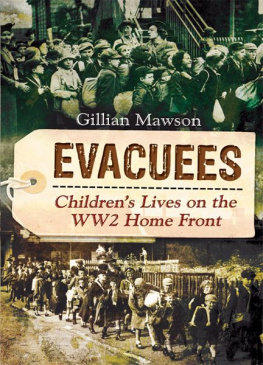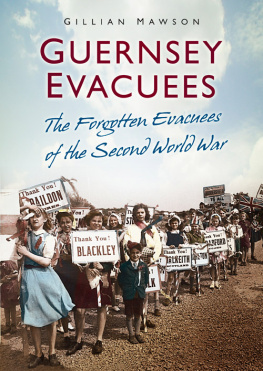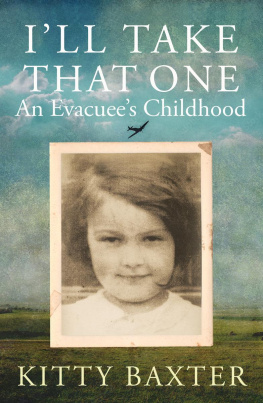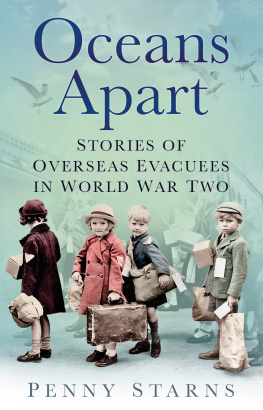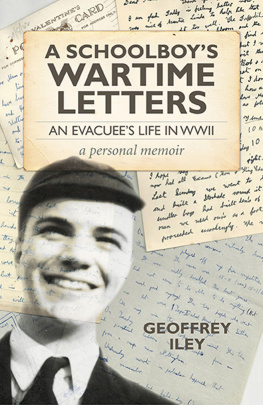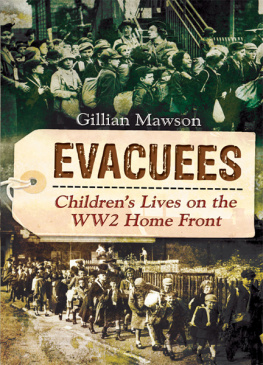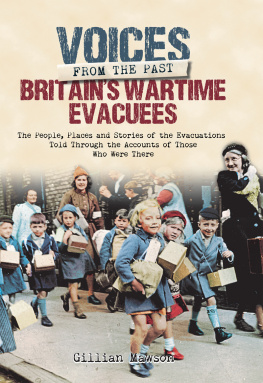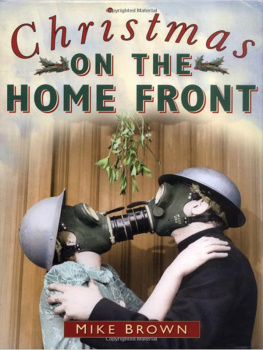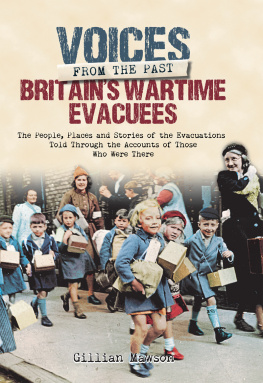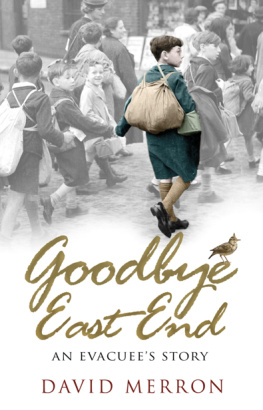This book is dedicated to all who have suffered as a result of war
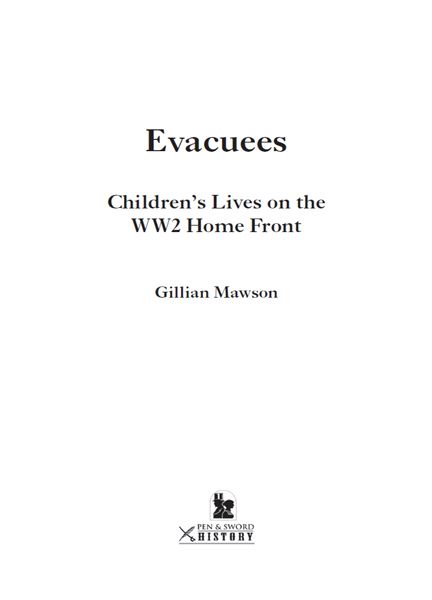
First published in Great Britain in 2014 by
Pen & Sword History
an imprint of
Pen & Sword Books Ltd
47 Church Street
Barnsley
South Yorkshire
S70 2AS
Copyright Gillian Mawson 2014
ISBN 978 1 78383 153 1
eISBN 9781473849495
The right of Gillian Mawson to be identified as the Author of this Work has been asserted by her in accordance with the Copyright, Designs and Patents Act 1988.
A CIP catalogue record for this book is available from the British Library
All rights reserved. No part of this book may be reproduced or transmitted in any form or by any means, electronic or mechanical including photocopying, recording or by any information storage and retrieval system, without permission from the Publisher in writing.
Typeset in Ehrhardt by
Mac Style Ltd, Bridlington, East Yorkshire
Printed and bound in the UK by CPI Group (UK) Ltd, Croydon,
CRO 4YY
Pen & Sword Books Ltd incorporates the imprints of Pen & Sword Archaeology, Atlas, Aviation, Battleground, Discovery, Family History, History, Maritime, Military, Naval, Politics, Railways, Select, Transport, True Crime, and Fiction, Frontline Books, Leo Cooper, Praetorian Press, Seaforth Publishing and Wharncliffe.
For a complete list of Pen & Sword titles please contact
PEN & SWORD BOOKS LIMITED
47 Church Street, Barnsley, South Yorkshire, S70 2AS, England
E-mail: enquiries@pen-and-sword.co.uk
Website: www.pen-and-sword.co.uk
Contents
Introduction
I have always had a passionate interest in social history and during 2013 I started to collect stories of evacuation from those who spent the war years away from home as evacuees in England, Northern Ireland, Scotland and Wales. Within this book, 100 of these moving stories are accompanied by photographs, many of which have been rescued from old suitcases and attics.
Prior to commencing work on Evacuees, I spent four years interviewing hundreds of evacuees from Guernsey for my first book, Guernsey Evacuees: The Forgotten Evacuees of the Second World War . Over 17,000 evacuees fled from Guernsey to England in June 1940, just weeks before the five-year occupation of their island by German forces began. Sadly, many of those I interviewed have since died and, in common with the aims of the Evacuees Reunion Association, I feel that it is vital that the memories of Second World War evacuees are recorded now, before they are lost for ever.
During the past year, I have interviewed people who were evacuated within Britain as part of Operation Pied Piper and discovered the stories of others who sought sanctuary in Britain from war-torn Europe. I also came across the memories of those who, in 1940, found refuge in England from British territories, like Guernsey, Jersey, Alderney and Gibraltar the majority were not sent to the safety of the countryside.
The aim of this book is to provide a particularly memorable incident or story from each evacuees reminiscences, encapsulating their personal experience of evacuation. These are presented together with a wartime family photograph, allowing an intimate glimpse into 100 lives affected by war. Several of the evacuees did not have the luxury of a camera during the war, but local history societies, newspapers and members of the public have kindly allowed me to use relevant photographs to illustrate their stories.
It was difficult to choose just one extract from each of these stories, as all represent a compelling and important part of British wartime history. Whilst preparing the stories for publication, however, it seemed natural to split them into five themes: Arrival and Departure depicts the initial upheaval of evacuation; A Different World reveals the culture shock for evacuees of finding themselves in a new environment, often completely dissimilar to their family home; in The Kindness of Strangers stories focus on the bonds forged between evacuees and their foster parents; Suffer the Little Children demonstrates that not all evacuees had positive wartime experiences; and We Were with the Children tells the foster parents and care-givers side of the story.
I have included stories from mothers and teachers who travelled with the schoolchildren and took on a huge responsibility. We tend to hear their stories far less often than those of child evacuees, yet they played a highly significant part in evacuation and it seems important to recognise this. In some cases schools were kept together as a unit and so the teachers became their pupils guardians for five years, in a move unprecedented in educational history.
Another theme running through many stories shatters the myth that most evacuees were deprived city children who left the slums for pristine homes in the countryside. Many of the former evacuees I spoke to recall being shocked when they were placed in country cottages with no running water, gas or electricity. Others discovered that their foster families were less than enthusiastic about their presence and endured severe homesickness.
However different, all of the stories in this book underline one thing: that there is so much more to the history of evacuation during World War Two than the images of children arriving at railway stations, clutching gas masks and with labels tied to their coats, which have entered the popular imagination. Hopefully, this book, with its combination of stories and family photographs, will paint an intimate picture of the different ways in which the British people opened up their homes to evacuated children and adults during the dark days of the Second World War.
Gillian Mawson, 2014
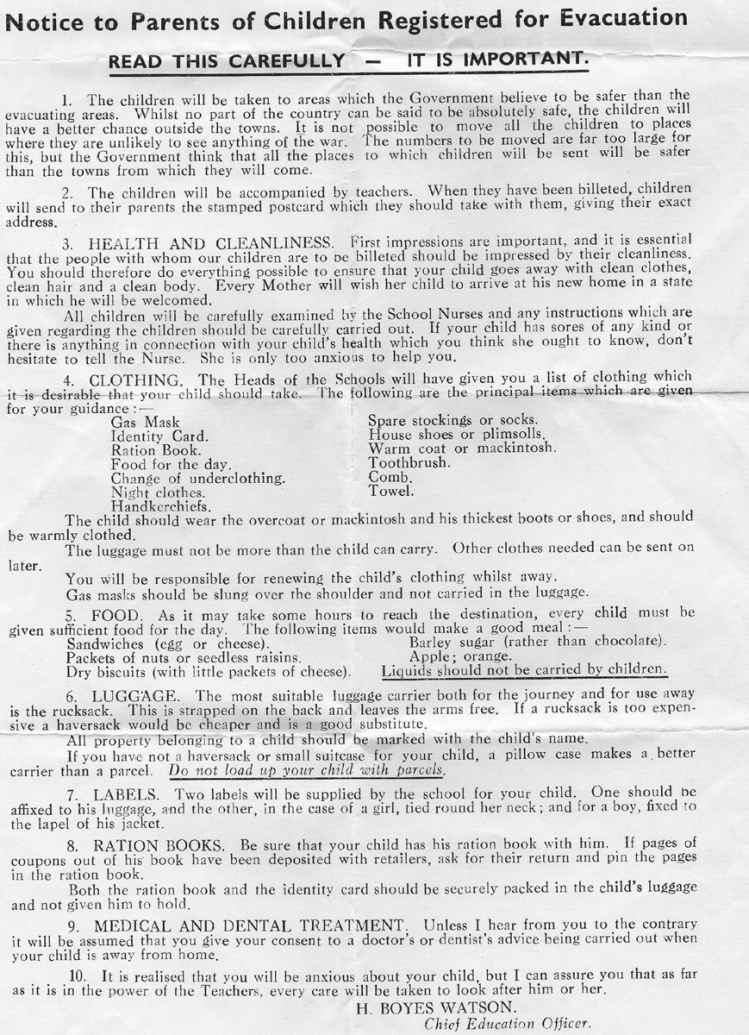
Official letter sent to parents notifying them of the arrangements for their childs evacuation. ( Courtesy of Dorothy Walsh ne Reynolds )
Chapter One
Arrivals and Departures: Embarking on Evacuation
T hese stories focus on evacuees poignant accounts of leaving their homes and arriving in evacuation reception areas. Some of the evacuees I interviewed still possess the evacuation instructions that they were given by their teachers. On the outbreak of war, parents were told to refer to the evacuation instructions and prepare a bag or rucksack containing the listed items that their child would need, should the call for evacuation arise.
Every day children would set off for school with their rucksack and a sandwich, in readiness for evacuation. Many children did not know if they would return home that day, whilst others had no real understanding of what evacuation actually meant. As they waved goodbye to their children each morning, parents had no idea whether they would return home from school that afternoon.

Guernsey evacuees John Helyer, Hazel Hall and June le Page leaving Bury, Lancashire in 1945. ( Courtesy of John Helyer )
Schools held regular evacuation drills and children would spend hours, standing in lines in the playground, being counted, having their identity labels checked, and the contents of their bags examined. Some even practised the walk to their nearest railway station. Children were also told to bring a stamped postcard with their home address clearly written on it, so that they could send their new address to their parents once they reached their new billet. They were instructed to write only cheerful messages that would not upset their parents, such as Dear Mum and Dad, I am in a good home here, and happy.
Next page
